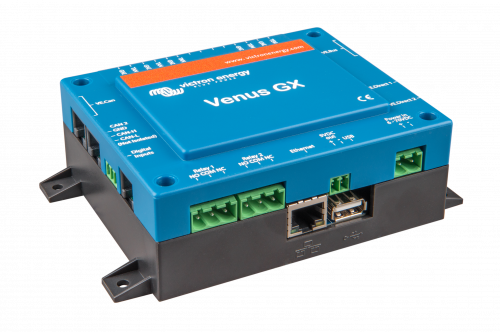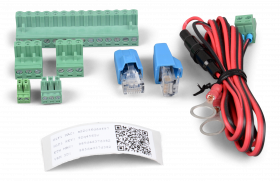This is an old revision of the document!
Table of Contents
Venus GX (VGX) manual
In many ways the Venus GX (VGX) and the Color Control GX (CCGX) are the same device. They share a lot of hardware, and they run on identical software - our 'Venus OS' - therefore firmware numbering is the same; and new version releases always apply to both devices at the same time.
As many of the functions of the two devices are identical, the CCGX Manual should also be consulted if something is not specifically covered in this VGX manual.
This manual refers to the latest firmware version. A device connected to the internet will perform new-version updates automatically. Check the latest firmware version here.
Venus GX/CCGX comparison table
1. What's in the Box?
- Venus GX (VGX)
- VE.Can terminator (2 pcs).
- Power cable with inline fuse and M8 terminal eyes for battery- or DC busbar-attachment.
- Terminal Blocks for all the connectors on each side.
- Label showing WiFi key and product details.
1.1 Overview of connections

2. Accessing the device
Because the Venus GX has no visual display or buttons, it is accessed for setting-up and monitoring by using the 'Remote Console' feature. You can do this through VRM, using the built-in WiFi Access Point, or by using the local LAN/WiFi network.
2.1 Accessing 'Remote Console' via VRM
Connect the Venus GX to the internet by plugging it into a working Ethernet network which as a DHCP server (most networks do). It will immediately connect to VRM.
Go to https://vrm.victronenergy.com/ and follow the instructions to add the device. More information about this is available in the VRM Manual.
When you've done that, click the 'Remote Console' link to open the window, like this:
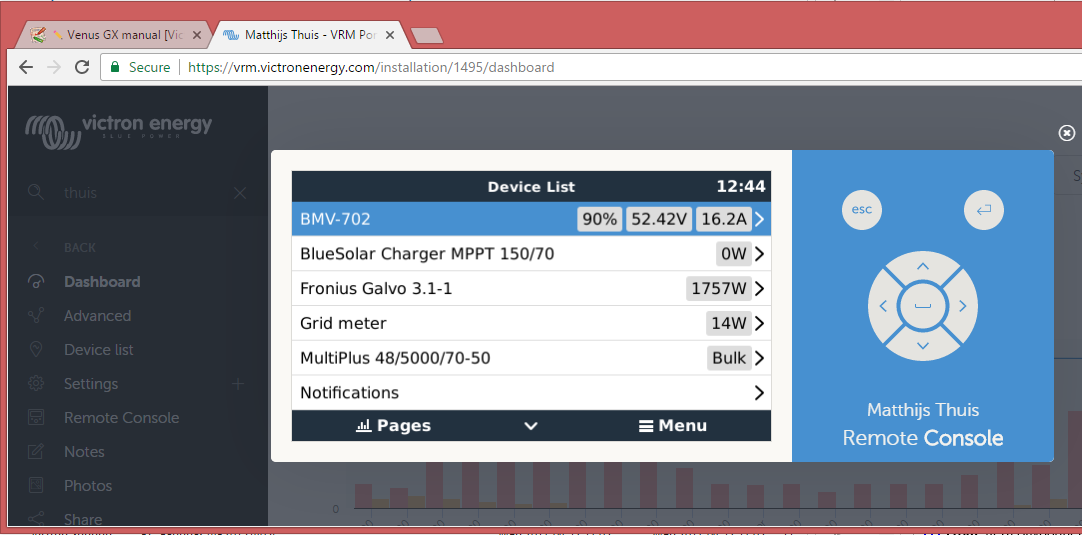
More information about 'Remote Console' on VRM is explained here.
2.2 Accessing 'Remote Console' via the built-in WiFi Access Point
Steps:
- Make sure you are no further than a few metres away from the Venus GX
- Go to the WiFi settings on your phone / tablet / laptop.
- After searching, it will show up in the list:
- Connect to WiFi using the 'WiFi key' which you will find printed on the side of the box …and also on a card in the plastic bag - which you should keep in a safe place.
- Open VictronConnect, and select the GX device from the Device list
- Select Remote Console - See this VictronConnect feature video for step by step instructions.
- If you cannot use VictronConnect, you can use a web browser and navigate to the IP address 172.24.24.1 - See this How to connect to the Venus GX video for step by step instructions.
Note that for added security it is possible to disable the WiFi Access Point. See Settings → Wi-Fi → Create access point.
Caution: Once WiFi Access is disabled the only way to get it back is by using 'Remote Console' on VRM -which requires a working internet connection; or via 'Remote Console' on LAN which requires a working network connection (but no internet).
2.3 Finding the IP address
If you've accidentally disabled Remote Console on VRM, the only way to re-enable it is via Remote Console on LAN. And to do that you'll need to find the IP address of the Venus GX. There are several ways of finding it:
IP Address on VRM
On VRM, you'll find the IP address on the Device List page of the installation. Note that this does require the Venus GX to be connected to the internet.
Network (on Microsoft Windows)
In a local network, for example at home, you can also find the Venus GX in the Windows 'Network' overview:
Double-clicking the icon will open up Remote Console on LAN.
Open the 'Properties' window to see the IP address.
This uses Universal plug-and-play broadcast technology.
3. LEDs and Push-button
3.1 LEDs
Boot-up
On the side of the Venus GX, there is a LED. During power-up it it goes through these states:
- Stage 1: Both green and red illuminate briefly and faintly (it's hard to see the green) for approximately 1 second.
- Stage 2: Red illuminates for approximately 1 second.
- Stage 3: Green illuminates for approximately 0.5 seconds.
- Stage 4: Both green and red illuminate briefly and faintly (it's hard to see the green) for approximately 1 second.
During operation
- Slow blinking: built-in WiFi access point disabled
- Fast blinking: built-in WiFi access point enabled (default)
Slow blinking is once per second. Fast blinking is twice per second.
3.2 Small button located to the right of the green 14-Terminal Connector Block
Short press: WiFi Access point on/off
A single short press toggles the internal WiFi access point on and off. The LED indicates its state: when the LED blinks green slow, then the built-in Access Point is disabled. when the LED is green and blinking fast, then the built-in Access Point is enabled.
Long press: reset all network settings to factory defaults
Press and hold the small button for a minimum of four seconds. The LED will stay on for 2 seconds to indicate that the log press has been recognised; then release the button again.
- Ethernet is set back to DHCP
- WiFi Access Point is enabled
- Remote Console password is disabled
- Remote Console on LAN and on VRM is enabled
The same button is available on the Octo GX, button is marked SD_BOOT and available under the lid at the top.
4. Digital Inputs
The Venus GX has five digital inputs. The channels are accessible via the RJ-12 socket on the side. This is available for self-wiring by the user/installer.
4.1. Wiring details
The inputs are non-isolated. They operate at 3V3 levels, and can withstand up to 5V input. Each input has an internal 10k pull-up resistor to 3V3. We recommend wiring it to a potential free relay or otherwise open collector/optocoupler output.
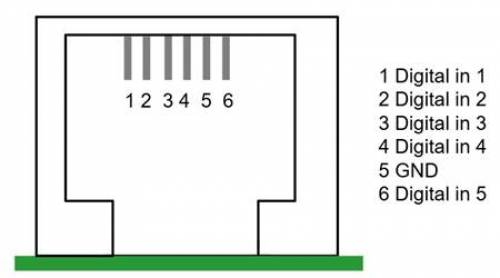
| RJ12 pinout | Input |
|---|---|
| pin1 | input1 |
| pin2 | input2 |
| pin3 | input3 |
| pin4 | input4 |
| pin5 | gnd |
| pin6 | input5 |
4.2. Configuration
Each of the digital inputs can be configured as a pulse meter, or as one of a number of predefined sensors that can also be configured as alarms.
The possible configurable functions are:
| Function | States |
|---|---|
| Pulse meter | N/A |
| Door alarm | Open/Closed |
| Bilge pump | On/Off |
| Bilge alarm | Ok/Alarm |
| Burglar alarm | Ok/Alarm |
| Smoke alarm | Ok/Alarm |
| Fire alarm | Ok/Alarm |
| CO2 alarm | Ok/Alarm |
| Generator | Running/Stopped |
The function of each input can be configured in the GUI under Settings → I/O → Digital Inputs.
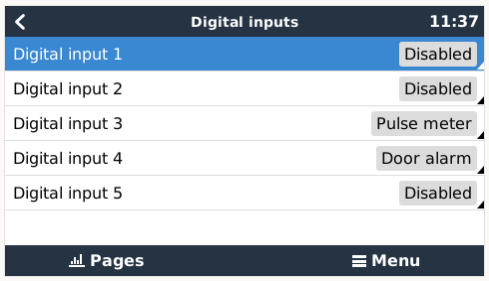
Once the input is configured for its intended purpose, it will show up with other devices.
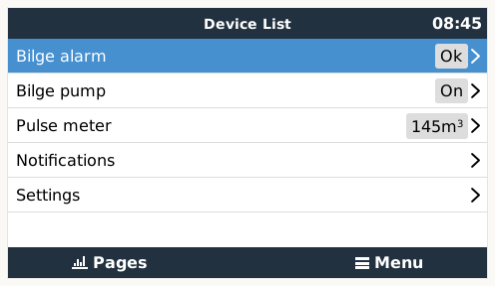
Other parameters related to that function can be configured by entering the device menu and selecting Setup. For pulse meters, you can configure the unit, the multiplier (the volume represented by each pulse) and reset the counter.
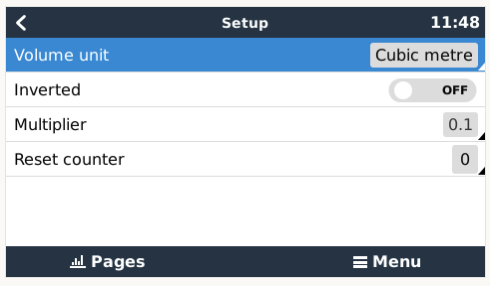
For other sensors and alarms, you can decide whether the input should be treated as an alarm condition, whether the labels should be inverted, and whether the logical levels should be inverted.
- To swap the labels attached to the alarm, set Inverted to on.
- If a logical low input (0V) should be considered a positive condition, set Inverted alarm logic to on.
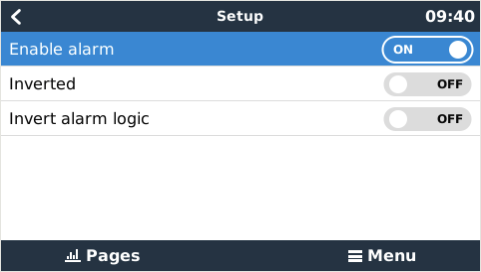
4.3. Read-out of digital inputs via Modbus-TCP
The values/states of the digital inputs are available on Modbus-TCP. For more details about this, please download a copy of the document “Modbus-TCP register list” from our website. And see our Modbus-TCP FAQ.
5. How does the Venus GX compare with the CCGX?
6. Factory reset
See above chapter 3.2 on the push button.
7. More information
DISQUS
~~DISQUS~~
 Add this page to your book
Add this page to your book  Remove this page from your book
Remove this page from your book  Manage book (
Manage book ( Help
Help 